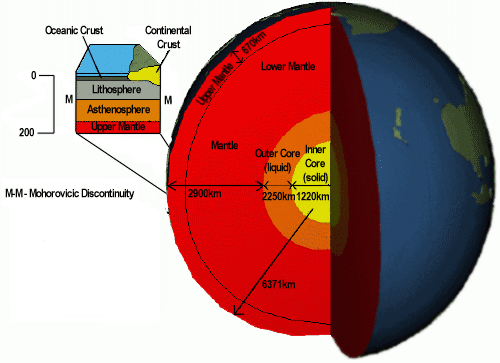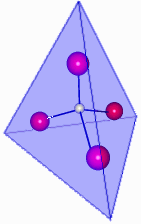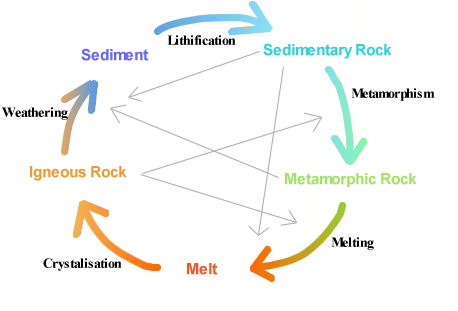An Introduction to Geology
About the author

Jon
Imperial College London
Introduction
Geology is, broadly speaking, the study of the Earth. It is split into several disciplines, including: Petrology (the study of rocks), Geophysics (the study of the Earth using physics), Palaeontology (the study of fossils) and Mineralogy (the study of minerals). The main aim of geology is to understand how the Earth works; how mountains are built, how the oceans form, what dinosaurs looked like. The Earth is constantly changing, both inside and outside. The atmosphere and water erode and weather rocks; collision of continents build mountain ranges; and new crust forms at the mid-ocean ridges. How do these processes relate to each other, and can we come up with a model to explain these things? Once we have such a model, the applications of geology become much simpler. Applications include the search for oil, gas, water and minerals; environmental studies; reconstructing the past environments of the Earth, which helps us with predicting the future.
Geology has been revolutionised by the introduction of the theory of plate tectonics. This theory explains a great deal of the things we see on the Earth's surface and helps a great deal when trying to fit the pieces together. It is plate tectonics which provides a model in which to put the details.
The Earth has a layered inner structure (Figure 1).

Figure 1: The interior structure of the Earth, with a close up of the lithosphere/asthenosphere boundary. Redrawn from Plummer & McGeary, 1997.
The Earth is made of three main layers: the lithosphere, the mantle and the core. This are split further, but this is beyond the scope of this tutorial. The lithosphere is divided into a series of plates which move around the surface of the Earth as dictated by plate tectonic theory. It is the lithosphere which is made of rock as we see it everyday.
Minerals
Minerals are the constituents of rocks, and hence of the Earth (at least the crust and mantle). Minerals consist of molecules and atoms arranged in an orderly manner and are therefore classified as crystalline solids. There are hundreds, if not thousands, of different minerals. There are dozens of groups of minerals, each with it's own type of structure. Every mineral is made of atoms, just like every other material. Atoms consist of protons and neutrons at the nucleus of the atom, with electrons orbiting around it (Figure 2).

Figure 2: The structure of the atom. The yellow spheres are electrons, the blue neutrons, the red protons. Redrawn from Plummer & McGeary, 1997.
The protons (red) have a positive charge, neutrons (blue) have no charge and electrons (yellow) have a negative charge. Due to the arrangement of these three constituent parts atoms do not have any overall charge. The sharing of electrons between atoms forms ions, which are atoms which have some charge. Connections between ions makes molecules. The molecules are then arranged in an orderly fashion to form the mineral (Figure 3). Most of the common minerals in rocks are silicates, which includes Quartz, Feldspar, Pyroxene and Hornblende.

Figure 3: A silica tetrahedra. Redrawn from Plummer & McGeary, 1997.
Silicates consist of silica and oxygen with some other ions. All silicate minerals have a structure based on the silica tetrahedra, an arrangement of 1 silica atom and 4 oxygen atoms (Figure 3). The chemical formula for this is SiO4. The main groups of minerals are: single, chains, double chains, sheets or framework arrangements of these tetrahedra. Most solid materials are crystalline - that is the atoms making this solid are arranged in a regular repeating order. If the materials is not crystalline, then it is amorphous. An amorphous solid is glass, which is a silicate liquid "frozen" solid.
A (geological) mineral is defined to be:
- A crystalline solid
- Naturally occurring
- Inorganic
- Definite chemical composition
Minerals have several important properties which help identify them:
- Colour - usually not a good indicator, as it depends on the exact chemistry.
- Streak - when ground up the mineral is always the same colour - it's streak.
- Luster - how light reflects from the mineral, e.g metallic minerals have a metallic luster.
- Hardness - reliable test. Harness is compared to Moh's hardness scale.
- Habit - the shape of the crystals, depends on the amount of growth.
- Fracture - how the mineral breaks when not along a cleavage plane.
- Cleavage - how the crystal breaks up. Cleavage planes are inherent planes of weakness.
What is a Rock?
What seems to be a simple question is actually very complicated. All rocks are ultimately made of minerals and there are three main types of rocks:
- Igneous
- Metamorphic
- Sedimentary
These are then subdivided into hundreds of different types of rocks.
Sedimentary rocks are made of fragments of other rocks; igneous, metamorphic or sedimentary. They are made when an older rock erodes or weathers to produce sediment, for instance sand on a beach. The sediment is then compacted and cemented together to produce a rock. Sedimentary rocks can also contain individual grains of minerals which have been eroded out of older rocks.
Igneous rocks are formed from the cooling of magma - molten rock. They are the rocks that form from volcanoes.
Metamorphic rocks are a result of heat and pressure on pre-existing rocks which undergo changes in the solid state. No melting occurs. They are associated with mountain belts and around igneous intrusions.
The Rock Cycle
The rock cycle shows how the three rock types relate to each other (Figure 4).

Figure 4: The rock cycle. Redrawn from Plummer & McGeary, 1997.
The four processes: weathering, crystallization, lithification and metamorphism are the links between the rock types, sediment and magma (molten rock). Weathering is the gradual wearing down of all rock types once they are exposed at the surface. Crystallization is the cooling of magma to form an igneous rock. Lithification is the transformation of loose sediment into a rock by a slight heating and/or cementation. Metamorphism occurs when a rock is subjected to heat and pressure, transforming a rock, but not melting it. This can occur on any rock, even a metamorphic rock.
Conclusion
Geology is the study of the Earth. The fundemental theory which underpins geology is the theory of plate tectonics. Rocks are divided into three basic groups: igneous rocks, which are formed from cooling of molten rocks; metamorphic rocks, which are rocks that have been altered by heat and pressure; and sedimentary rocks, which are rocks formed from clasts of older rocks or chemically precipitated. All rocks are formed of minerals, which are regular arrangements of molecules into crystals. The rocks are linked together by the rocks cycle.
References
C. Plummer and D. McGeary, 1997. Physical Geology.
 GeologyRocks
GeologyRocks